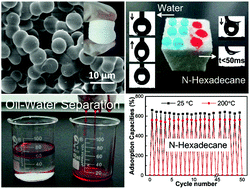Ternary silicone sponge with enhanced mechanical properties for oil–water separation†
Abstract
Silicone sponges have been developed and applied over the years for the separation of oil–water mixtures. However, the materials suffer from a poor mechanical performance under cyclic operations. In this work, we report the preparation of ternary silicone sponges via a facile sol–gel process using methyltrimethoxysilane (MTMS), dimethyldimethoxysilicane (DMDMS) and tetraethylorthosilicate (TEOS) as precursors. Special emphasis is put on illustrating the role of TEOS on the morphology, mechanical and thermal properties of the developed silicone sponge. The results show that the introduction of TEOS into the binary silicone sponge resulted in a higher degree of crosslinking reactions, as verified by the chain-like structures in the sample, and the much enhanced mechanical properties and thermal stability of the material. More importantly, the optimized ternary sponge displayed a stable superhydrophobicity, a high efficiency for separating various organic liquids from water, and an excellent recyclability under cyclic operations. The excellent structural and thermal stability of the optimized sponge make it an ideal candidate to be used in the separation industry and for environmental remediation.


 Please wait while we load your content...
Please wait while we load your content...